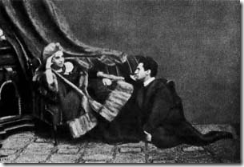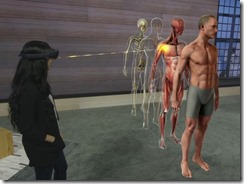
The Kinect sensor and other NUI devices have introduced an array of newish interaction patterns between humans and computers: tap, touch, speech, finger tracking, body gestures. The hololens provides us with a new method of interaction that hasn’t been covered extensively from a UX perspective before: The Gaze. Hololens performs eye tracking in order to aid users of the AR device to activate menus.
Questions immediately arise as to the role this will play in surveillance culture, and even more in the surveillance of surveillance culture. While sensors track our gaze, will they similarly inform us about the gaze of others? Will we one day receive notifications that someone is checking us out? Quis custodiet ipsos custodes? To the eternal question who watches the watchers, we finally have an answer. HoloLens does.

Even though The Gaze has not been analyzed deeply from a UX perspective, it has been the object of profound study from a phenomenological and a structuralist point of view. In this post I want to introduce you to five philosophical treatments of The Gaze covering the psychological, the social, the cinematic, the ethical and the romantic. To start, the diagram above is not from an HCI book as one might reasonably assume but rather from a monograph by the psychoanalyst Jacques Lacan.

A distinction is often drawn between Lacan’s early studies of The Gaze and his later conclusions about it. The early work relates it to a “mirror stage” of self-awareness and concerns the gaze when directed to ourselves rather than to others:
“This event can take place … from the age of six months on; its repetition has often given me pause to reflect upon the striking spectacle of a nursling in front of a mirror who has not yet mastered walking or even standing, but who … overcomes, in a flutter of jubilant activity, the constraints of his prop in order to adopt a slightly leaning-forward position and take in an instantaneous view of the image in order to fix it in his mind.”
This notion flowered in the later work The Split Between the Eye and the Gaze into a theory of narcissism in which the subject sees himself/herself as an objet petit a (a technical term for an object of desire) through the distancing effect of the gaze. Through this distancing, the subject also become alienated from itself. What is probably essential for us in this work – as students of emerging technologies – is the notion that the human gaze is emotionally distancing. This observation was later taken up in post-colonial theory as the “Imperial Gaze” and in feminist theory as “objectification.”
Michel Foucault achieved fame as a champion of the constructivist interpretation of truth but it is often forgotten that he was also an historian of science. A major theme in his work is the way in which the gaze of the other affects and shapes us – in particular the “scientific gaze.” Being watched causes us discomfort and we change our behavior – sometimes even our perception of who we are – in response to it. The grand image Foucault raises to encapsulate this notion is Jeremy Bentham’s Panopticon, a circular prison in which everyone is watched by everyone else.
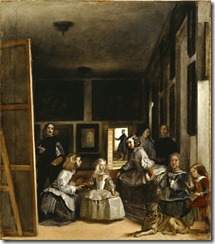
Where Lacan concentrates on the self-gaze and Foucault on the way the gaze makes us feel, Slovoj Zizek is concerned with the appearance of The Gaze when we gaze back at it. He writes in an essay called “Why Does the Phaullus Appear” from the collection Enjoy Your Symptom:
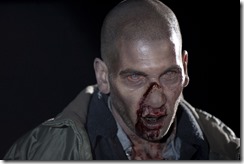
“Let us take the ‘phantom of the opera,’ undoubtedly mass culture’s most renowned specter, which has kept the popular imagination occupied from Gaston Leroux’s novel at the turn of the century through a series of movie and television versions up to the recent triumphant musical: in what consists, on a closer look, the repulsive horror of his face? The features which define it are four:
“1) the eyes: ‘his eyes are so deep that you can hardly see the fixed pupils. All you can see is two big black holes, as in a dead man’s skull.’ To a connoisseur of Alfred Hitchcock, this image instantly recalls The Birds, namely the corpse with the pecked-out eyes upon which Mitch’s mother (Jessica Tandy) stumbles in a lonely farmhouse, its sight causing her to emit a silent scream. When, occasionally, we do catch the sparkle of these eyes, they seem like two candles lit deep within the head, perceivable only in the dark: these two lights somehow at odds with the head’s surface, like lanterns burning at night in a lonely, abandoned house, are responsible for the uncanny effect of the ‘living dead.’”
Obviously whatever Zizek says about the phantom of the opera applies equally well to The Walking Dead. What ultimately distinguishes vampires, zombies, demons and ghosts lies in the way they gaze at us.
While Zizek finds in the eyes a locus for inhumanity, the ethicist Emmanual Levinas believes this is where our humanity resides. These two notions actually complement each other, since what Zizek indentifies as disturbing is the inability to project a human mind behind a vacant stare. As Levinas says in a difficult and metaphysical way in his masterpiece Totality and Infinity:
“The presentation of the face, expression, does not disclose an inward world previously closed, adding thus a new region to comprehend or to take over. On the contrary, it calls to me above and beyond the given that speech already puts in common among us…. The third party looks at me in the eyes of the Other – language is justice. It is not that there first would be the face, and then the being it manifests or expresses would concern himself with justice; the epiphany of the face qua face opens humanity…. Like a shunt every social relation leads back to the presentation of the other to the same without the intermediary of any image or sign, solely by the expression of the face.”
The face and the gaze of the other implies a demand upon us. For Levinas, unlike Foucault, this demand isn’t simply a demand to behave according to norms but more broadly posits an existential command. The face of the other asks us implicitly to do the right thing: it demands justice.
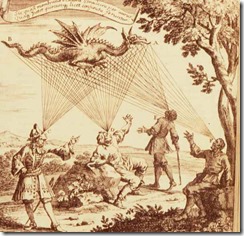
The final aspect of the gaze to be discussed – though probably the first aspect to occur to the reader – is the gaze of love, i.e. love at first sight. This was a particular interest of the scholar Ioan P. Couliano. In his book Eros and Magic in the Renaissance Couliano examines old medical theories about falling in love and cures for infatuation and obsession. He relates this to Renaissance theories about pneuma [spiritus, phantasma], which was believed to be a pervasive fluid that allowed objects to be sensed through apparently empty air and become transmitted to the brain and the heart. In this regard, Couliano raises a question that would only make sense to a true Renaissance man: “How does a woman, who is so big, penetrate the eyes, which are so small?” He quotes the 13th century Bernard of Gordon:
“The illness called ‘hereos’ is melancholy anguish caused by love for a woman. The ‘cause’ of this affliction lies in the corruption of the faculty to evaluate, due to a figure and a face that have made a very strong impression. When a man is in love with a woman, he thinks exaggeratedly of her figure, her face, her behavior, believing her to be the most beautiful, the most worthy of respect, the most extraordinary with the best build in body and soul, that there can be. This is why he desires her passionately, forgetting all sense of proportion and common sense, and thinks that, if he could satisfy his desire, he would be happy. To so great an extent is his judgment distorted that he constantly thinks of the woman’s figure and abandons all his activities so that, if someone speaks to him, he hardly hears him.”
And here is Couliano’s gloss of Bernard’s text:
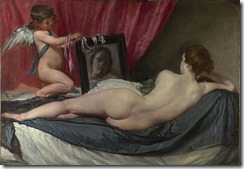
“If we closely examine Bernard of Gordon’s long description of ‘amor hereos,’ we observe that it deals with a phantasmic infection finding expression in the subject’s melancholic wasting away, except for the eyes. Why are the eyes excepted? Because the very image of the woman has entered the spirit through the eyes and, through the optic nerve, has been transmitted to the sensory spirit that forms common sense…. If the eyes do not partake of the organism’s general decay, it is because the spirit uses those corporeal apertures to try to reestablish contact with the object that was converted into the obsessing phantasm: the woman.”
[As an apology and a warning, I want to draw your attention to the use of ocular vocabulary such as “perspective,” “point of view,” “in this regard,” etc. Ocular phrases are so pervasive in the English language that it is nearly impossible to avoid them and it would be more awkward to try to do so than it is to use them without comment. If you intend to speak about visual imagery, take my advice and pun proudly and without apology – for you will see that you have no real choice in the matter.]
